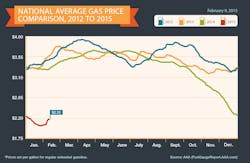(WASHINGTON, February 9, 2015) The national average price for regular unleaded gasoline has increased every day for two weeks for a total of 14 cents per gallon. Gas prices had previously dropped for a record 123 consecutive days before beginning to rise again on January 27. Today’s price of $2.18 per gallon is 12 cents more than one week ago and three cents more than one month ago. While prices have moved higher recently, the national average remains significantly less expensive than one year ago when consumers were paying $1.11 more per gallon on average to refuel their vehicles.
February typically marks the start of seasonal refinery maintenance in preparation for the busy summer driving season. Refineries usually schedule maintenance during the first several months of the year when demand is relatively low, which can lead to decreased production and supplies.
There is additional market uncertainty this week because approximately 5,200 members of the United Steelworkers union have walked off their jobs at refineries and chemical plants responsible for processing more than 10 percent of U.S. petroleum products. While this is the first nationwide strike at U.S. oil refineries since 1980, the work stoppage is not expected to have a significant impact on production in the short-term because refineries continue to operate. While news of the strike has reportedly led to higher wholesale gasoline prices, abundant petroleum supplies may provide both refiners and unions with a chance to reach an agreement before there is a larger impact on consumers.
Five states are registering averages below $2 per gallon, representing 20 fewer than one week ago. Thirty-nine states are posting averages below $2.25 per gallon, and for the second week in a row motorists in Idaho ($1.89) are paying the least per gallon for retail gasoline. The Rocky Mountain states of Utah ($1.90) and Montana ($1.93) round out the nation’s least expensive markets. Hawaii ($3.05) is the only state posting an average above $3 per gallon, and is joined by California ($2.63), Alaska ($2.60), New York ($2.42) and Washington, D.C. ($2.41) as the nation’s top five most expensive markets.
On the whole, consumers are paying a bit more to refuel their vehicles compared to one week ago. Week-over-week prices are higher in 48 states and Washington, D.C. Over this same period consumers in 32 states are paying a dime or more per gallon, with the largest increases experienced by drivers in Ohio (+19 cents), California (+18 cents), Minnesota (+17 cents) and Kansas (+16 cents). Hawaii (-6 cents) and Alaska (-4 cents) were the only two states to see price declines.
Two-week price comparisons also reflect increases in the average price for retail gasoline in 45 states and Washington, D.C. Drivers in 30 states are paying a dime or more per gallon at the pump over this span, led by the Midwestern states of Ohio (+35 cents), Illinois (+28 cents) and Michigan (+27 cents) where the price has increased by a more than a quarter per gallon over this period. The price at the pump has fallen in five states during the same span, with the biggest drops seen in Hawaii (-19 cents) and Alaska (-12 cents).
The majority of U.S. drivers are continuing to enjoy month-over-month savings. However, price comparisons are a bit more balanced than prior weeks with averages down in 29 states and Washington, D.C. Consumers in Hawaii (-38 cents), Alaska (-35 cents) and Vermont (-25 cents) are saving the most per gallon, and 16 states and Washington D.C. are registering discounts of more than a dime per gallon. On the other end of the spectrum, motorists in 21 states are paying more at the pump. The price has jumped by a dime or more per gallon in 11 states versus one month ago, with the largest increases in price seen in Michigan (+26 cents), Ohio (+23 cents) and Indiana (+23 cents).
Motorists universally continue to experience yearly savings at the pump. With the exception of Nevada (-99 cents) and Hawaii (-98 cents), the price is down by $1 or more per gallon in every state and Washington, D.C. Drivers in three states: Connecticut (-$1.33), Maine (-$1.26) and Rhode Island (-$1.26) are saving more than $1.25 per gallon, which is 10 fewer states than last week’s report.
An oversupplied global market is expected to keep the price of crude relatively low for at least the first half of 2015. Nonetheless, the global market’s overall volatility is at a six-year high and prices have seesawed, often daily, in response to a number of factors that are putting pressure on the balance between supply and demand. High-cost production countries continue to reassess their overall production goals, and Saudi Arabia is currently maneuvering to protect its market share by adjusting prices to various countries, including Asia and the United States.
This past week WTI traded between the high $40s and low $50s, reflecting the global market’s volatility. At the close of Friday’s formal trading on the NYMEX, WTI was up $1.21 to settle at $51.69 per barrel.





